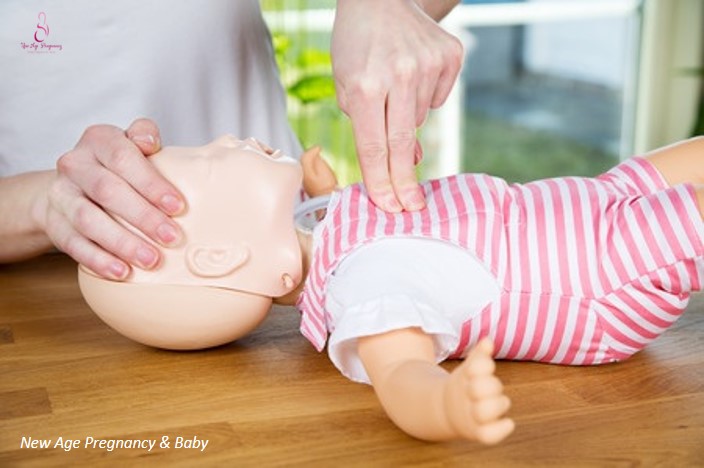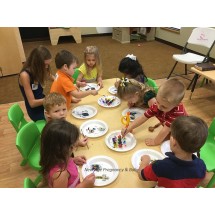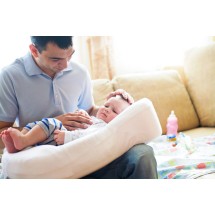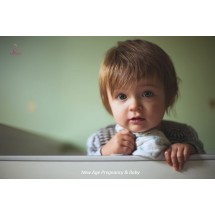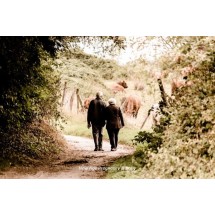Prevention is most important and safety should be a priority when caring for babies and young children. However, accidents happen and parents should be prepared for common emergency situations, and know first aid techniques to help the child. Below are the common emergencies and tips on what parents can do:
#1 Drowning
Drowning may happen at swimming pool but can also happen at home, in the bath tub, toilet bowl or basin filled with water. Always support your baby during a bath, ensuring that both the nose and mouth are above the water level. Should you find your baby unconscious (from suspected drowning), call his name and gently tap the sole of his foot. Never shake your baby. Open the baby’s airway by gently tilting the head back by placing one hand on the forehead. Use the other hand to lift the chin. Listen and feel for breathing, while observing the rise and fall of the chest.
If your baby is breathing normally, cradle the baby in your arms with head tilted slightly downwards. Call for ambulance. If your baby is not breathing, call for ambulance immediately and perform CPR.
Cardiopulmonary resuscitation (CPR)
It is important to take a course on CPR in preparation for emergency situations. CPR for babies is more “gentle” than that for adults. Open the baby’s airway and seal your mouth against the baby’s mouth and nose. Blow steadily into the baby’s mouth for one second, the chest should rise. When you take your mouth away, the chest should fall. Repeat for four more puffs. Chest compression for babies are also gentler – place two fingers of your lower hand onto the centre of the baby’s chest. Press down by one third of the depth and release the pressure. Give 29 more pumps. Continue with giving 2 puffs and 30 chest presses, and repeat this cycle until help comes.
#2 Choking
Choking can happen anywhere as any small object is a choking hazard. If the baby looks like he is choking, sit down and hold the baby face down along your thigh while supporting his head. Give five sharp blows between the shoulder blades with the heel of your hand. Check the baby’s mouth to see if there is any object and pick out the object carefully without pushing it into the airway. If the blockage does not clear, call an ambulance immediately and repeat the back blows and chest thrusts till help comes.
#3 Objects in nose or ear
Apart from putting small objects in the mouth, babies may also put objects into their nose or ear. You may notice breathing difficulty, swelling in the nose or blood-stained discharge from the nose. If object is in the ear, your baby may not respond well to sound and the ear drum may be damaged. Do not try to remove the object on your own; encourage your baby to breathe through the mouth and avoid pushing objects further into the nose.
#4 Anaphylactic shock
Anaphylactic shock is a severe allergic reaction, for instance to specific foods like peanuts or shellfish. An allergic reaction can develop within a few seconds – it can be in the form of hives or facial/lip swelling, vomiting or diarrhea to breathing difficulty, tightness in the throat and fast heart beat. An anaphylaxis requires immediate treatment, using an epi-pen which gives a dose of epinephrine into the blood stream when injected. Epinephrine can quickly reduce swelling, thereby reversing/ preventing the swelling of airways.
If you notice symptoms of a severe allergic reaction, give the epi-pen immediately and call for an ambulance. Sit the baby on your lap leaning slightly forward to help with the breathing or lie down if in shock. If the baby is not breathing normally and not responsive, begin CPR.
#5 Seizures
Seizures are sometimes due to high temperature because a baby’s brain is not well developed to cope with the increase in temperature. Seizures are evident from vigorous shaking with clenched first and arched back, facial twitching, fixed or upturned eyes, reddened face and neck with drooling at the mouth, reduced response, vomiting or loss of control of bowel/ bladder. If you see your baby having seizures, put pillows around to prevent injury and clear away dangerous objects. When the seizure has stopped, cradle baby in your arms towards you with baby’s head tilted slightly downwards. Call for an ambulance.
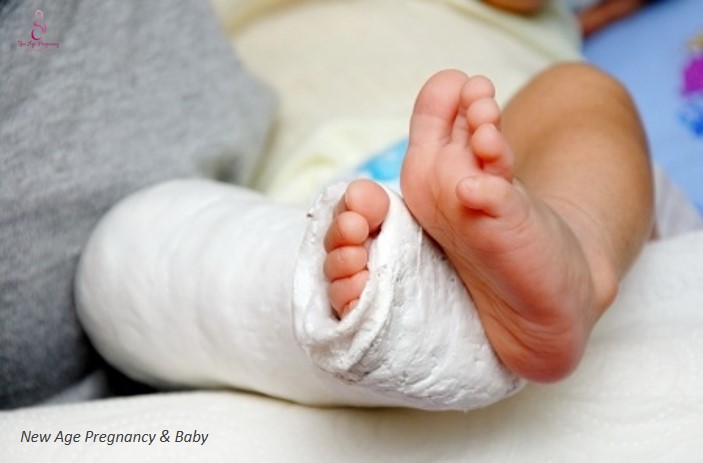
#6 Dislocation
As baby’s joints are more delicate, they can get dislocated more easily. Dislocation can happen when pulling your baby up by their hands or pull of the limbs in an abnormal position. Dislocations are painful, and you may also notice that there is limited/ awkward movement, swelling, bruising or deformity. Instead of trying to “fix” the dislocation, you should immobilise the injury with a sling or broad fold bandage. Call an ambulance and while waiting for help, check for baby’s breathing and ensure there is no blood circulation cut-off from the bandage.
#7 Head injury
Severe head injury may lead to unconsciousness, vomiting, drowsiness, seizures or fluid draining from ears or nose. Call the ambulance for severe head injury and for minor bump, apply a cold compress wrapped in cloth against the bump. Do not move a child with neck or head injury.
#8 Burns
Burns are categorised as first. second or third degree burns depending on the extent of skin damage. Burns in babies and young children can come from hot fluids or food, flame or hot objects, electrical burns or chemical burns. For burns that cover a large area or burns with inner tissue damage, go to emergency.
At home, for minor burns, run cool water over the burned area or hold a cold compress (but not ice) over the affected area. Do not use ice, grease, butter or powder. Remove clothing from the burned area. Protect the area with a sterile gauze and give acetaminophen for pain. For more serious burns, don’t break the blister, and cover the area with a clean dry cloth after applying cool water.
#9 Poisoning
If you suspect your child of poisoning, it is helpful to know what chemical he has consumed and bring it along to emergency. Call for emergency ambulance.
#10 Sprain/ Fracture
As it is not always easy to tell a sprain from a fracture, if in doubt, take your child to the emergency department for an x-ray. For first aid for sprains, apply the RICE technique:
R for Rest, at least 24 hours
I for Ice, for 15 minutes every few hours for the first two days to prevent swelling (not heat)
C for Compression/ Comfortable support, wearing an elastic bandage to reduce swelling
E for Elevation, to keep the injured part above heart level
For fractures, apply splints around the injured limb to prevent further injury if the child has to be moved. Splints can be made with boards, padded with clothing and the splints should extend beyond the joints.
#11 Cuts/ Severe bleeding
If the cut results in severe bleeding, call for ambulance and apply pressure on the bleeding area with a gauze or clean piece of cloth. Remove the baby’s clothing to see if there is any object in the wound and do not remove the object. Raise the injured area above the baby’s heart and maintain pressure (but not too tight that circulation is cut off).
#12 Heat Cramps/ Exhaustion/ Stroke
Heat cramps are muscle cramps due to sweating under heat that reduces the level of salts in the muscles. The child needs to replenish fluids that contain salts and sugar, and rest in a cool place. Gentle stretching and massage also help. Heat exhaustion is more severe, resulting in fainting, nausea, clammy skin and increased body temperature. Bring the child to a cool place, remove excess clothing and drink salt and sugar containing fluids. Put cool wet cloth on the child’s skin and bring the child to doctor to assess if intravenous fluids are required. Heat stroke is most severe as the body cannot regulate its own temperature and can increase to 41 degrees celsius and cause brain damage. Heat stroke in babies or young children may happen if a child is left in a car on a hot day – even twenty minutes can raise the body temperature. Do not give the child fluids if he is not awake.
First aid kit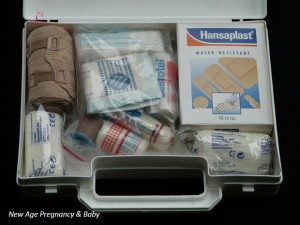
First aid kit is important as it makes it easier to attend to your baby in a more efficient and calm manner. For young children, the first aid requires some modifications such as:
(i) non-glass thermometer,
(ii) mild cleanser, in place of harsh soap or antiseptic wipe,
(iii) nasal aspirator,
(iv) pain relief medication suited for children,
(v) epi-pen (if prescribed) and first aid chart for young children.
Keep calm in all emergencies and always check for baby’s breathing and be ready to perform CPR if breathing stops. Have ready the following emergency numbers to call:
995 – Emergency ambulance, Fire
1777 – Non-emergency ambulance
64239119 – Drugs and Poison (non-emergency)
1800 752 1800 – Gas leaks
Written by Mei

